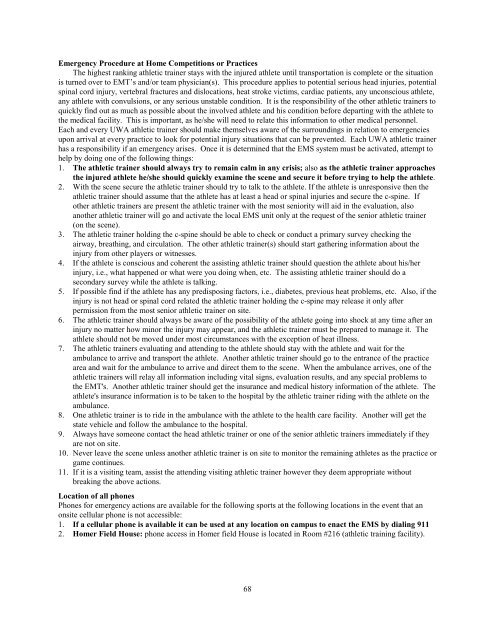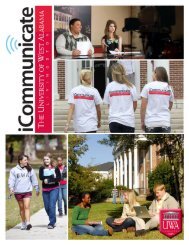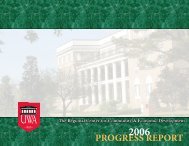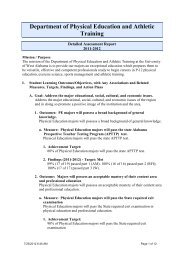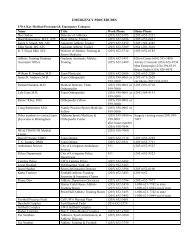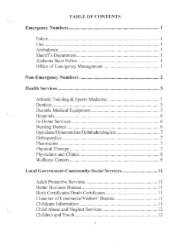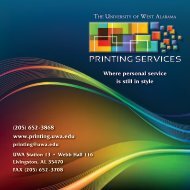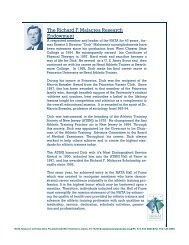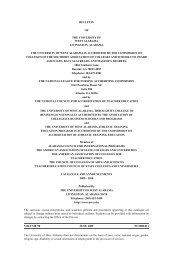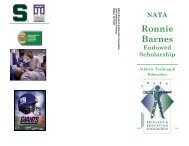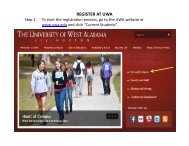table of contents - UWA Athletic Training & Sports Medicine Center
table of contents - UWA Athletic Training & Sports Medicine Center
table of contents - UWA Athletic Training & Sports Medicine Center
Create successful ePaper yourself
Turn your PDF publications into a flip-book with our unique Google optimized e-Paper software.
Emergency Procedure at Home Competitions or PracticesThe highest ranking athletic trainer stays with the injured athlete until transportation is complete or the situationis turned over to EMT’s and/or team physician(s). This procedure applies to potential serious head injuries, potentialspinal cord injury, vertebral fractures and dislocations, heat stroke victims, cardiac patients, any unconscious athlete,any athlete with convulsions, or any serious uns<strong>table</strong> condition. It is the responsibility <strong>of</strong> the other athletic trainers toquickly find out as much as possible about the involved athlete and his condition before departing with the athlete tothe medical facility. This is important, as he/she will need to relate this information to other medical personnel.Each and every <strong>UWA</strong> athletic trainer should make themselves aware <strong>of</strong> the surroundings in relation to emergenciesupon arrival at every practice to look for potential injury situations that can be prevented. Each <strong>UWA</strong> athletic trainerhas a responsibility if an emergency arises. Once it is determined that the EMS system must be activated, attempt tohelp by doing one <strong>of</strong> the following things:1. The athletic trainer should always try to remain calm in any crisis; also as the athletic trainer approachesthe injured athlete he/she should quickly examine the scene and secure it before trying to help the athlete.2. With the scene secure the athletic trainer should try to talk to the athlete. If the athlete is unresponsive then theathletic trainer should assume that the athlete has at least a head or spinal injuries and secure the c-spine. Ifother athletic trainers are present the athletic trainer with the most seniority will aid in the evaluation, alsoanother athletic trainer will go and activate the local EMS unit only at the request <strong>of</strong> the senior athletic trainer(on the scene).3. The athletic trainer holding the c-spine should be able to check or conduct a primary survey checking theairway, breathing, and circulation. The other athletic trainer(s) should start gathering information about theinjury from other players or witnesses.4. If the athlete is conscious and coherent the assisting athletic trainer should question the athlete about his/herinjury, i.e., what happened or what were you doing when, etc. The assisting athletic trainer should do asecondary survey while the athlete is talking.5. If possible find if the athlete has any predisposing factors, i.e., diabetes, previous heat problems, etc. Also, if theinjury is not head or spinal cord related the athletic trainer holding the c-spine may release it only afterpermission from the most senior athletic trainer on site.6. The athletic trainer should always be aware <strong>of</strong> the possibility <strong>of</strong> the athlete going into shock at any time after aninjury no matter how minor the injury may appear, and the athletic trainer must be prepared to manage it. Theathlete should not be moved under most circumstances with the exception <strong>of</strong> heat illness.7. The athletic trainers evaluating and attending to the athlete should stay with the athlete and wait for theambulance to arrive and transport the athlete. Another athletic trainer should go to the entrance <strong>of</strong> the practicearea and wait for the ambulance to arrive and direct them to the scene. When the ambulance arrives, one <strong>of</strong> theathletic trainers will relay all information including vital signs, evaluation results, and any special problems tothe EMT's. Another athletic trainer should get the insurance and medical history information <strong>of</strong> the athlete. Theathlete's insurance information is to be taken to the hospital by the athletic trainer riding with the athlete on theambulance.8. One athletic trainer is to ride in the ambulance with the athlete to the health care facility. Another will get thestate vehicle and follow the ambulance to the hospital.9. Always have someone contact the head athletic trainer or one <strong>of</strong> the senior athletic trainers immediately if theyare not on site.10. Never leave the scene unless another athletic trainer is on site to monitor the remaining athletes as the practice orgame continues.11. If it is a visiting team, assist the attending visiting athletic trainer however they deem appropriate withoutbreaking the above actions.Location <strong>of</strong> all phonesPhones for emergency actions are available for the following sports at the following locations in the event that anonsite cellular phone is not accessible:1. If a cellular phone is available it can be used at any location on campus to enact the EMS by dialing 9112. Homer Field House: phone access in Homer field House is located in Room #216 (athletic training facility).68


